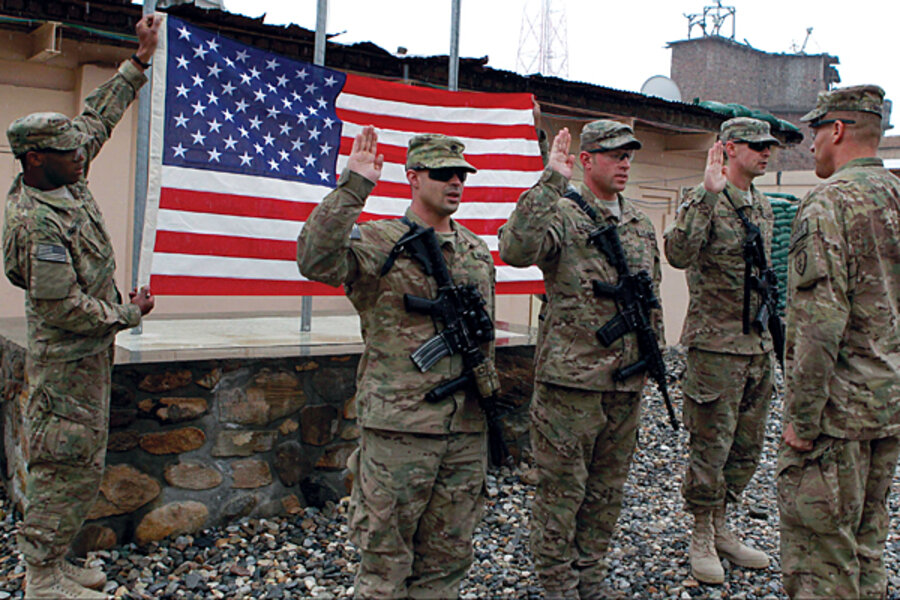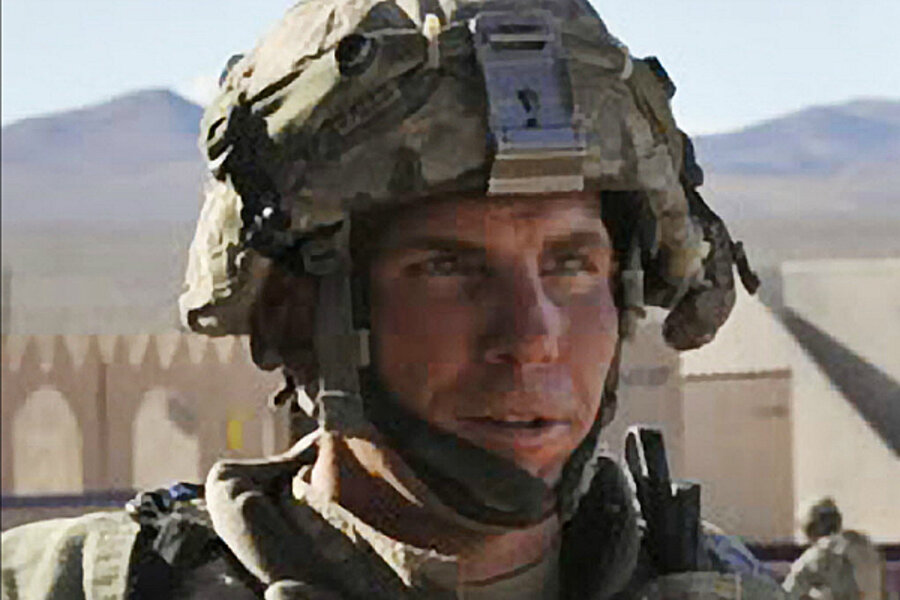Sgt. Robert Bales and multiple tours of duty: How many is too many?
Loading...
| Washington
The tremendous burden that battle places on soldiers – and the notion that it can push some to their breaking point – has long been one of the fatalistically accepted miseries of war.
During the Civil War, this breaking point was called, alternately, “soldier’s heart” and “exhausted heart.” In World War I, it was “war neurosis,” “gas hysteria,” and “shell shock.” Sigmund Freud had his own theory about the “inner conflict” between a soldier’s “peace ego” and its “parasitic double,” the “war ego.”
But the case surrounding Staff Sgt. Robert Bales, who stands suspected of gunning down 17 Afghan civilians – including nine children – in a murderous March rampage, is likely to spotlight the unique toll that repeated deployments to decade-long conflicts in Iraq and Afghanistan have taken on America’s soldiers.
Bales’s lawyer, John Henry Browne, has hinted that he will argue post-traumatic stress disorder (PTSD) played a role in his client’s alleged crime. “He doesn’t remember everything the evening in question – that doesn’t mean he has amnesia,” Mr. Browne told reporters. “There are lots of other options.”
Browne might argue, too, that it is the US military’s fault for not properly treating the mental wounds of war of his client, who had deployed to Iraq three times before being sent – against his will, Browne has said – to Afghanistan.
Defense Secretary Leon Panetta has carefully disavowed Bales’s alleged crime as the lone action of a lone gunman, for which the Pentagon may well seek the death penalty.
But the Pentagon acknowledges, too, the stresses put on its force by repeated deployments. Some 107,000 Army soldiers have been deployed to war three or more times since 2001, or some 20 percent of the active-duty force. More than 50,000 of those currently in uniform have completed four or more combat tours, Army figures indicate.
America’s current conflicts “represent not only the longest wars fought by our Army, but also the longest fought by an all-volunteer force,” placing “tremendous and unique burdens on our soldiers and families as compared to the previous conflicts,” notes a wide-ranging study of soldiers’ mental health released by the Army earlier this year.
The study was particularly adamant that any attempt to view "soldier misconduct in isolation" necessarily "fails to capture the real likelihood that the misconduct was associated with an untreated physical or behavioral health condition, such as increased aggression associated with PTSD."
That's because in some cases the burdens of repeated deployments have been greater than those troops had endured in World War II, the study warns. The average infantryman in the South Pacific “saw about 40 days of combat in four years” in contrast to a “persistently high” level of fighting in Iraq and Afghanistan, which has offered “very few opportunities for individuals to rest, either physically or mentally.”
The Pentagon has grappled with just how many deployments is too many. A 2010 study known as the “Red Book” discovered in those who had completed multiple tours “a growing high-risk population of soldiers engaging in criminal and high-risk behavior with increasingly more severe outcomes including violent crime.”
Precursors of this behavior, the study noted, were “combat-related wounds, injuries and illnesses; repetitive and lengthy separations, and broader economic conditions.” Bales’s lawyer might point out that his client struggled with all three.
Many troops wrestle with the strains of repeated trips to war zones. Tech Sgt. Bob Roberts has completed 15 deployments in 17 years since joining the Air Force’s elite pararescuers, who were most recently serving as a quick-reaction force for the final troops pulling out of Iraq. During the past four years, Roberts estimates he has been away from home more than 300 days a year. A former professional snowboarder, Roberts says the key to doing the job he loves is learning how “to keep your personal freakout at bay” amid violent chaos that sometimes requires “picking up pieces of people.”
He is quick to acknowledge that war has taken its toll. Roberts is on his fourth marriage. “I’ve chosen this over relationships – over everything else,” he says. The majority of pararescuers he began serving with, he adds, have turned violence inward and are now either “in jail, have a bullet in their head, or are drug abusers.”
Wary of painting a picture of every soldier who returns from war as wrestling with deep pathology, military officials stress that the majority of those who have served multiple tours have done so without committing crimes against civilians.
But they grapple with the simple soldierly reality that going into battle and all it entails necessarily cultivates aggressive behavior. What troops “have been through in the past 10 years requires more attention, more understanding – and it requires ways to channel that energy that we’ve encouraged them to have and bring to the fight – so that when they come back to the States, they don’t self-destruct,” says Lt. Col. Thomas Hanson, of the Office of Security Cooperation in Iraq (OSC-I).
Some try to create ad-hoc therapies. Lt. Col. Jonathan Downing, chief of doctrine and education at the OSC-I, witnessed the risk-taking behaviors that troops in his 800-person squadron would engage in upon their return from war. “We saw a lot of guys coming home, getting on sports bikes, and going crazy,” he says.
He and his colleagues decided to pay for motorcycle track days for those who seemed to “need that adrenaline” they had become accustomed to in combat. Risk-taking is “obviously a legitimate concern,” Downing says, “so we’re trying to use our influence to channel it.”
Just how the US military has chosen to cope with its war-sick has varied throughout history. Gen. George Patton, in one of the more notorious leadership moments of World War II, felt compelled to slap a crying 18-year-old soldier in a field hospital for being a “coward.”
Less remembered is the general outpouring of compassion that act prompted. Gen. Dwight Eisenhower sent a letter of reprimand to Patton, who had hit crying soldiers on more than one occasion, writes F. Don Nidiffer and Spencer Leach in a 2010 article published in Developments in Mental Health Law.
“I am well aware of the necessity for hardness and toughness on the battlefield,” Eisenhower admonished. “But this does not excuse ... abuse of the ‘sick.’ ” Congress concurred, stepping in to delay a command promotion for Patton.
Attempts have increased to understand war trauma and to use psychiatry to pinpoint which troops will suffer inordinately from what they have seen and done, but they remain primitive, military officials say. “There’s going to be lots of soul-searching and teeth-gnashing, but the reality is that we can’t tell when somebody is going to snap,” says Ronald Smith, director of psychiatry at Walter Reed National Military Medical Center in Bethesda, Md.
Dr. Smith recalls doing screenings for Antarctica missions. “I’m supposed to be pretty good at this, but you’d say that somebody’s going to have a terrible time, and they’d do great. Another guy you’d think would cruise through it would come apart,” he adds.
The bottom line is that war is a gruesomely powerful and ultimately unwieldy force that has the capacity to change the people who fight it in ways large, small, or negligible – but nearly always unpredictable. “Horrible, wretched tragedies that brook no understanding can in fact happen at war because you threaten people’s survival,” Smith, a Navy captain, says. The solution for preventing such tragedies, he adds, “is that our appetite for war should go away – and we should only do it when everything else fails.”
In the meantime, psychiatrists must often grapple in cases like Bales’s with “that sickening feeling [that] we don’t know and we can’t explain it,” he adds. “That will be up to a jury of his peers. But there’s not to my knowledge a neuropsychologist in the world who can say this was predictable.”
It is a frustration echoed by Gen. Peter Chiarelli, who, as the Army’s second-ranking officer, spearheaded the service’s mental-health outreach efforts until he retired this year. “We have no reliable diagnostics,” he says. “That was the frustrating thing for me for 3-1/2 years.”
Chiarelli, now chief executive officer for One Mind for Research, is pushing for collaborative research that he hopes will ultimately help troops who have been fighting the longest wars in American history. For now, however, the tools remain limited.
“The military is the only organization I know of that screens its people when they enter the service, before they deploy, while they are deployed, when they return, and six months after they return,” Chiarelli says. “If we had reliable tools, don’t people think we’d use them?”








